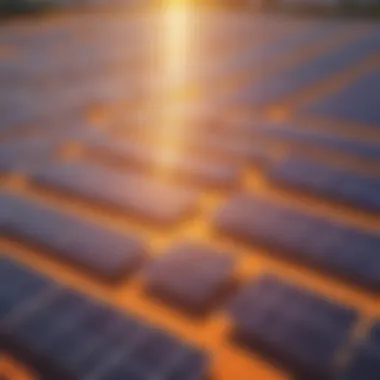Evaluating Clean Energy Sources for a Sustainable Future


Intro
As we delve into the landscape of clean energy sources, a pressing need emerges for sustainable solutions to replace conventional fossil fuels. Numerous stakeholders, including students, investors, advisors, managers, and analysts, are increasingly focused on understanding the potential of alternative energy sources. These sources, which include solar, wind, and geothermal energy, offer promising avenues for reducing carbon footprints while promoting economic growth.
By comparing the myriad benefits and challenges associated with each energy type, this exploration aims to furnish key insights that allow informed decision-making. It's not merely about switching off the fossil fuel tap, but rather, it’s about tapping into opportunities that lay in cleaner energy options.
Whether you’re a budding entrepreneur in clean tech, an avid student of environmental sciences, or an investor on the lookout for green alternatives, grasping the core concepts surrounding these energy sources is vital.
Defining Clean Energy
Clean energy is increasingly a significant topic as the world grapples with the complexities of climate change and energy sustainability. As we explore the various clean energy sources available, defining clean energy is essential because it lays the groundwork for understanding how these sources can impact our environment, economy, and day-to-day life.
When we talk about clean energy, we often refer to energy generated from renewable resources that produce minimal or no emissions. This includes sources such as solar, wind, and geothermal energy. Unlike fossil fuels, clean energy aims to minimize environmental damage and promotes a sustainable approach to energy consumption.
Characteristics of Clean Energy
Clean energy boasts several distinctive characteristics that set it apart from traditional energy sources. These characteristics include:
- Renewability: Clean energy is derived from sources that can regenerate naturally. Solar radiation, wind patterns, and hydroelectric cycles can be harnessed continuously without depleting the resource.
- Low Emissions: One of the most attractive features of clean energy is its low environmental impact. For example, wind turbines and solar panels produce electricity without releasing greenhouse gases.
- Diverse Applications: Clean energy isn't just one-size-fits-all. It can be employed in various sectors, from heating homes to powering electric vehicles, thereby making it versatile.
- Energy Independence: Using local clean energy sources can reduce a country’s reliance on imported fossil fuels, leading to enhanced energy security.
In summary, clean energy aims to provide sustainable solutions that benefit both society and the planet.
Importance of Transitioning to Clean Energy
Transitioning to clean energy is not merely a trend; it is critical for ensuring a viable future for our planet and its inhabitants. This shift carries immense significance in multiple sectors, impacting everything from the economy to public health.
"Shifting to clean energy is like turning the ship: slow at first but crucial for navigating towards a sustainable horizon."
The importance of this transition can be highlighted through several key points:
- Mitigating Climate Change: Fossil fuels are the leading contributors to greenhouse gas emissions, a key driver of global warming. Clean energy reduces these emissions, thus playing an essential role in combating climate change.
- Economic Opportunities: As the clean energy market expands, it opens doors for new jobs and businesses. Investments in these technologies can foster economic growth and innovation.
- Public Health Benefits: Cleaner air and reduced pollution directly correlate with better health outcomes. Communities that transition to clean energy often see lower rates of respiratory illnesses and other pollution-related health issues.
- Long-term Sustainability: The finite nature of fossil fuels calls for a shift towards sustainable sources. Investing in clean energy cultivates a resilient energy landscape capable of meeting future demands.
Solar Energy
Solar energy stands out as one of the most promising clean energy sources in the quest to reduce dependence on fossil fuels. With the sun providing a virtually limitless resource, it offers a sustainable solution to meet the growing energy demands of the modern world. This section will explore the mechanisms behind solar energy production, its numerous advantages, and the challenges that arise in its implementation.
Mechanisms of Solar Energy Production
Understanding how solar energy is harnessed is crucial to appreciate its impact. Solar power relies primarily on Photovoltaic (PV) systems, which convert sunlight directly into electricity. When sunlight hits the solar cells, it excites electrons, creating an electric current. This process occurs thanks to semiconductors, typically silicon, that absorb the photons from the sun.
The main types of solar energy systems include:
- Grid-tied Systems: These are connected to the public electricity grid and can feed surplus energy back into it, providing a potential return on investment.
- Off-grid Systems: These setups work independently of the grid, usually incorporating batteries to store energy.
- Concentrated Solar Power (CSP): This system employs mirrors or lenses to concentrate a large area of sunlight, producing heat that drives a generator.
Importantly, advancements in technology, such as improvements in solar panel efficiency and the development of energy storage solutions, are continuously enhancing the potency of solar energy production.
Advantages of Solar Energy
The transition to solar energy is supported by a myriad of benefits. One of the most critical advantages is its environmental impact. Solar power produces clean energy without releasing harmful greenhouse gases, thus playing a pivotal role in combating climate change.
Other noteworthy benefits include:
- Sustainability: As long as the sun shines, solar energy can be harnessed, making it a renewable resource.
- Economic Aspects: The solar energy sector has spurred job creation in manufacturing, installation, and maintenance.
- Energy Independence: Utilizing solar energy can reduce a region’s dependence on imported fuels, potentially stabilizing energy costs.
- Enhancements in Energy Security: Solar installations can be set up in remote areas, providing electricity to underserved communities.
"Solar energy is the most abundant energy source on Earth, allowing us to power our needs while protecting our planet for generations to come."
Challenges in Solar Energy Implementation
Despite its many advantages, solar energy faces several hurdles that can impede its widespread adoption. The chief challenges include:
- High Initial Costs: The upfront investment for solar panels and installation can be considerable, often deterring homeowners and businesses.
- Intermittency Issues: Solar energy production is inherently variable, depending on weather conditions and time of day, which complicates consistent energy supply.
- Space Requirement: Solar farms need significant land areas, which can lead to conflicts over land use, especially in urban settings.
- Technological Limitations: While advancements are ongoing, efficiency losses and the lifespan of solar panels remain. Management of solar waste, especially when panels reach the end of their life cycle, is an emerging concern.
Wind Energy
Wind energy stands as a formidable contender in the arena of clean energy solutions. With the growing concern over climate change and energy sustainability, harnessing the power of the wind becomes increasingly vital. It offers both an effective means of reducing greenhouse gas emissions and a solid strategy for energy independence. Wind farms, often dotted across landscapes, symbolize not only advancements in technology but also the global shift towards greener, renewable energy sources. So, let's delve deeper into how it all comes together.
How Wind Energy Works
At its core, wind energy is about converting kinetic energy from the wind into usable power. This process begins with wind turbines, which consist of large blades attached to a rotor. When wind blows, it causes the blades to spin, turning the rotor and activating a generator that then produces electricity. This conversion is executed via several key components:
- Blades: Typically made of fiberglass or carbon fiber, these blades catch the wind, helping them spin efficiently.
- Rotor: It connects the blades to the generator, converting their rotational motion into electrical energy.
- Generator: This unit transforms the rotational energy into electricity, which is then sent through transformers for distribution.


Wind energy can be harvested both onshore and offshore. Onshore installations are usually located in open areas where wind is consistently flowing, while offshore operations tap into the high winds over oceans and lakes. Each method has its nuances but shares the common goal of generating renewable power.
Benefits of Wind Power
The advantages of wind power extend beyond mere electricity generation. Here's a closer look at a few highlights:
- Environmentally Friendly: Wind energy is a clean source, producing no pollutants during operation and using no water, unlike fossil fuel plants that can harm waterways.
- Job Creation: The wind industry has created a substantial number of jobs in manufacturing, installation, and maintenance of wind turbines, benefiting local economies.
- Sustainable: Wind is inexhaustible. Unlike fossil fuels, wind won't run out, ensuring a reliable energy supply for generations.
- Reduced Operating Costs: Once turbines are installed, the cost of harnessing wind energy tends to be lower compared to traditional power sources due to minimal fuel expenses.
- Energy Independence: Countries investing in wind power can reduce their reliance on imported fuels, enhancing energy security.
"The potential for wind energy is immense; as technology advances, so do the possibilities for creating cleaner, more sustainable energy solutions."
Drawbacks and Limitations of Wind Energy
Despite the favorable qualities of wind energy, some challenges persist. Understanding these limitations is crucial for a balanced perspective:
- Intermittency: Wind isn't always blowing. Energy production can fluctuate, which poses a challenge for reliable energy supply.
- Visual and Noise Impact: Some communities express concerns over the aesthetic impact of wind turbines on landscapes and the noise generated during operation.
- Wildlife Disruption: Turbines can pose threats to flying animals, particularly birds and bats, leading to potential ecological disruptions.
- Initial Capital Costs: Setting up a wind farm requires significant upfront investment, including infrastructure costs, which can be a barrier for some investors.
With these points in mind, a thoughtful approach is needed when considering wind energy as a core component of our transition to sustainable energy solutions. Overall, when expanded properly, wind energy can play a pivotal role in the global effort to mitigate climate change.
Hydroelectric Energy
Hydroelectric energy stands as one of the long-established sources of renewable energy, portraying itself as a pivotal player in the global shift from fossil fuels. With its ability to produce vast amounts of electricity while leveraging the natural power of flowing water, this energy source has carved out a substantial niche in the energy market. More than just a means for generating power, hydroelectric energy reflects a complex interplay between technology, the environment, and society, making it indispensable in discussions surrounding sustainable energy.
Principles of Hydroelectric Power Generation
Hydroelectric power generation operates fundamentally on the principle of converting the kinetic energy of moving water into mechanical energy and then into electric energy. Generally, this process can be clustered into three core steps:
- Water Flow: A dam is built to create a reservoir. As water collects in the dam, gravitational potential energy increases.
- Turbine Motion: Water is then released from the reservoir, flowing through turbines. The force of the water spins the turbines, transforming the water's kinetic energy into mechanical energy.
- Electric Generation: Finally, the turbines are connected to generators, which convert the mechanical energy into electricity.
Estimates reveal that hydroelectric systems can convert over 90% of the potential energy into electricity, making it one of the most efficient energy sources.
Advantages of Hydroelectric Energy
Hydroelectric energy boasts numerous benefits that contribute to its significance within the renewable energy landscape:
- Renewable Nature: Hydropower utilizes the Earth's water cycle, genuinely making it a renewable resource as long as weather patterns remain consistent.
- Low Emissions: Since the generation of electricity from water does not produce harmful emissions, hydroelectric power plants are vital for reducing greenhouse gas emissions.
- Energy Storage Capabilities: Many hydroelectric systems can act like batteries, storing energy by holding water in reservoirs. This capability becomes invaluable during peak demand periods.
- Economic Development: These projects often create jobs, boost local economies, and can support additional infrastructure initiatives in surrounding areas.
"Hydroelectric systems offer a nearly carbon-neutral opportunity for countries looking to reduce emissions and increase sustainable energy production."
Environmental and Social Challenges
Despite its numerous advantages, hydroelectric energy does not come without challenges that warrant careful consideration:
- Ecosystem Disruption: The creation of reservoirs can lead to significant changes in local ecosystems, displacing wildlife and altering habitats.
- Water Management: Controlling river flows can affect water quality and availability downstream, impacting agriculture, drinking water, and local communities.
- Sociocultural Impact: The construction of large dams can displace local populations, raising ethical concerns regarding human rights and community welfare.
- Climate Vulnerability: Changing climate patterns can affect the water flow crucial for hydroelectric energy production, making long-term plans challenging.
As with any energy source, while hydroelectric energy presents a clear boon for clean energy production, addressing these challenges is equally important to maximize its benefits.
Geothermal Energy
Geothermal energy represents a promising and often underappreciated sector within the clean energy landscape. This energy source, which derives from the Earth’s internal heat, has the potential to provide sustainable power while reducing reliance on fossil fuels. The significance of geothermal energy lies in its low emission profile, ability to supply baseload power, and its longevity as a resource. Unlike other renewables, geothermal isn't influenced by weather conditions; it generates a steady supply, which can enhance overall stability in energy grids.
Understanding Geothermal Energy
Geothermal energy taps into the heat stored beneath the Earth's surface. This heat can come from a variety of sources, including the decay of radioactive materials and the original formation of the planet. The energy harnessed can be used for a wide array of applications, from direct heating in residential properties to generating electricity through geothermal power plants.
The process isn’t as complicated as one might think. It typically involves drilling wells below the Earth’s surface to access hot water or steam, which is then brought back to the surface to generate energy. There are different types of geothermal systems, including ground source heat pumps and hydrothermal systems, which utilize the natural heat flow found in certain locations.
Pros of Utilizing Geothermal Energy
The advantages of geothermal energy are robust and multifaceted:
- Sustainability: It provides a long-term, stable energy source.
- Reduced Carbon Footprint: The emissions from geothermal plants are significantly lower than those from fossil fuel plants.
- Energy Independence: Utilizing domestic geothermal resources can help nations reduce their reliance on imported fossil fuels.
- Economic Benefits: Geothermal energy projects can create jobs and stimulate local economies.
- Baseload Energy Supply: Unlike other renewables like wind or solar, geothermal energy can deliver power continuously, making it ideal for meeting base load energy demands.
Limitations of Geothermal Power Sources
While geothermal energy holds many promises, it is not without its challenges and limitations:
- Location Dependent: Geothermal resources are not evenly distributed; they are concentrated in specific regions, often near tectonic plate boundaries.
- High Initial Investment: The costs associated with drilling and establishing geothermal plants can be substantial.
- Induced Seismicity: The process of extracting geothermal energy can sometimes contribute to geological instability.
- Limited Resource Life: In some cases, geothermal reservoirs may decrease in output if not managed properly.
As this clean energy source garners more attention, ongoing research and technology advancements may mitigate some existing limitations, paving the way for a more widespread adoption of geothermal solutions.
"Geothermal energy stands out as a consistent and capable energy source, providing power around the clock, unaffected by weather."
While geothermal energy might not be the first source that comes to mind when discussing renewables, its potential to contribute significantly to the energy landscape cannot be overstated. Through understanding its methods, advantages, and constraints, stakeholders can make informed decisions in this rapidly evolving domain.


Biomass Energy
Biomass energy emerges as a noteworthy player in the field of renewable energies, and its relevance in today's energy discussions is gaining traction. This energy source represents a practical way to reduce the carbon footprint while leveraging organic materials as fuel. Biomass refers to the biological material from plants and animals, which can be converted into usable energy, quite diverse in nature. It plays a significant role in both rural and urban areas, often making use of waste materials that would otherwise be discarded.
When focusing on biomass energy, it's essential to understand its multiple layers—from production methods through to its inherent benefits and the concerns it brings. This section will deliver insights into the process of generating biomass energy, the overall advantages it can yield, as well as the limitations and controversies surrounding its utilization.
Biomass Energy Production Methods
Producing energy from biomass can be approached through various methods, commonly categorized as thermal, biochemical, and chemical processes.
- Thermal Conversion: This involves burning biomass directly to produce heat. It can also include gasification, where biomass is converted into gas before combustion, making it more efficient.
- Biochemical Processes: Biomass can be broken down by microbes or enzymes, leading to fermentation, which produces biogas. Another common practice is anaerobic digestion, where organic materials decompose in absence of oxygen.
- Chemical Processes: This encompasses transesterification, often used to produce biodiesel from vegetable oils or animal fats. Each production method differs in efficiency, cost, and sustainability.
Addressing these methods not only highlights the versatility of biomass energy but also underscores the necessity for continual innovation and improvement to increase efficiency and reduce environmental impacts.
Benefits of Biomass as a Renewable Resource
Using biomass as an energy source offers several compelling advantages:
- Sustainability: Biomass is renewable and can be replenished, unlike fossil fuels, given that it harnesses materials that would be wasted.
- Waste Reduction: Utilizing agricultural and urban waste helps in minimizing landfill waste, leading to a cleaner environment.
- Energy Security: Biomass can contribute to energy independence, reducing reliance on imported fossil fuels and creating local jobs.
- Carbon Neutrality: When biomass is burnt, it releases carbon dioxide, but since the plants absorb CO2 during growth, it can be considered carbon-neutral.
Above all, these benefits reflect a more sustainable approach to energy production, one that aligns with the global vision for a cleaner future.
Concerns and Drawbacks of Biomass Energy
However, burning biomass isn’t without its own set of challenges. The concerns surrounding biomass energy merit a close examination:
- Land Use: The production of biomass can involve significant land use, potentially impacting food production and leading to deforestation.
- Air Quality Concerns: Combustion of biomass can emit pollutants, such as particulate matter and other volatile organic compounds, affecting air quality negatively.
- Economic Viability: In some cases, biomass energy may not be competitive with fossil fuels in terms of price, making it a less attractive option for investors.
- Sustainability Questions: Not all biomass energy sources are equally sustainable. Relying heavily on unsustainable practices can lead to environmental degradation.
"Biomass energy represents a middle ground in the pursuit of cleaner energy, but its implementation must be carefully managed to truly align with sustainability goals."
Understanding these points provides a more comprehensive view of biomass energy and aids in informed discussions about its potential roles in the future energy landscape.
Emerging Clean Energy Technologies
The landscape of clean energy is evolving rapidly, with emerging technologies paving the way toward efficient and sustainable energy solutions. To comprehend fully the horizon of these advancements, one must consider several critical factors. These technologies not only promise to address existing energy demands but also enhance energy security and sustainability. As we delve into these new frontiers, the focus will lie on the innovations in energy storage solutions, along with the role of hydrogen fuel cells, both of which are essential components in the optimization of clean energy utilization.
Innovations in Energy Storage Solutions
Energy storage has become a cornerstone in harnessing renewable resources effectively. With the intermittent nature of sources such as solar and wind, efficient storage solutions can level out energy availability, ensuring a consistent power supply. One of the most promising innovations in this realm is the development of advanced battery technologies.
- Lithium-ion Batteries: Currently the most prevalent, these batteries are known for their high energy density and efficiency. Their decreasing costs are making them more accessible, paving the path toward widespread adoption.
- Solid-state Batteries: They hold significant promise due to their enhanced safety features and greater energy density. Though still in the development phase, their commercialization could revolutionize electric mobility and grid storage.
- Flow Batteries: This technology is particularly attractive for long-duration storage. It operates by pumping liquid electrolytes through a cell, allowing for scalable energy storage solutions.
The importance of these innovations cannot be overstated. As energy demands rise, enhancing storage capabilities ensures that the energy produced can be reliably directed where it’s needed without loss or waste.
"Energy storage is not just about keeping power for later; it’s about transforming how we think about energy accessibility entirely."
The Role of Hydrogen Fuel Cells
Hydrogen fuel cells represent another pillar of emerging clean energy technologies. These devices convert hydrogen and oxygen into electricity, with water as the only byproduct, positioning them as a clean alternative to traditional fossil fuels. Their impact stretches across various sectors, including transportation, industrial processes, and stationary power generation.
- Transportation: Hydrogen fuel cell vehicles (FCVs) are becoming more prevalent. Their range and rapid refueling times give them an edge over battery-powered electric vehicles in certain applications, particularly heavy-duty and long-distance transportation.
- Industrial Applications: Many industries are seeking to reduce carbon emissions, and hydrogen offers a pathway to decarbonize processes that are difficult to electrify. It can replace natural gas in high-temperature applications.
- Grid Stability: By storing excess energy from renewables as hydrogen, it can serve as an energy carrier, balancing supply and demand effectively.
The adoption of hydrogen fuel cells hinges on overcoming challenges such as production costs, distribution infrastructure, and public perception. However, the benefits they offer in reducing greenhouse gas emissions make them a critical area of focus for future clean energy agendas.
Global Perspectives on Clean Energy
As the world grapples with the urgent need to shift away from fossil fuels, the global perspectives on clean energy become increasingly vital. This section dives into how different countries and cultures approach clean energy, highlighting the importance of international collaboration, shared initiatives, and policy frameworks that can drive the transition towards a sustainable future. Understanding these perspectives can empower investors, policymakers, and managers to align their strategies with global trends.
Energy is not produced or consumed in a vacuum; its impact spans borders, economies, and societies. Countries are finding that cooperation in clean energy fosters innovation and accelerates progress. The sharing of technology and best practices can lead to more effective solutions tailored to local contexts while also addressing global challenges like climate change and energy security.
International Clean Energy Initiatives
Around the globe, a multitude of initiatives exist that underline the commitment to clean energy. Several high-profile collaborations, treaties, and agreements illustrate the global drive towards sustainability. For instance, the Paris Agreement sets a binding commitment for nations to reduce greenhouse gas emissions, showcasing a collective effort to combat climate change. Moreover, specific programs like the International Renewable Energy Agency (IRENA) act as platforms for cooperation.
Key initiatives include:
- Fossil Fuel Subsidy Reform: Many countries are reassessing their financial support for fossil fuels, realizing that reallocating these funds towards clean energy could dramatically alter the energy landscape.
- Clean Energy Action Plan (CEAP): This initiative promotes widespread adoption of renewable technologies by providing financial resources and technical expertise to developing countries.
- Global Wind Energy Council’s Initiatives: Collaborates with various countries to enhance wind energy production, recognizing wind power's potential in combating climate issues.
These initiatives serve not only as frameworks for national policy but as models for how nations can work in tandem to meet global challenges.
Comparative Analysis of Global Energy Policies


Energy policies can vary significantly from region to region, reflecting differing priorities, resources, and socio-economic contexts. A comparative analysis of these policies reveals insights about the effectiveness of various approaches to clean energy.
For instance, while Germany has pioneered the Energiewende, or "energy transition," policy, focusing heavily on solar and wind energy, China has taken the lead in manufacturing renewable energy technologies and investing in mass deployment.
Critical factors in this analysis include:
- Regulatory Framework: Countries with clear and supportive regulatory policies tend to see more investment in clean energy technology. Nations like Denmark have created robust frameworks that promote wind energy development.
- Financial Incentives: Tax breaks, subsidies, and funding for research and development play crucial roles. For instance, the Investment Tax Credit (ITC) in the United States spurred solar energy growth significantly.
- Public Acceptance and Engagement: Policies that include community input typically see better outcomes. Exploring how public perceptions shape policy can provide lessons on improving acceptance of clean energy projects.
"In the realm of energy, it's not just about the source; it's about the strategy that gets us there."
In summary, understanding global perspectives on clean energy and identifying transformative initiatives as well as policy patterns reveals critical insights for stakeholders. It highlights how collaboration and well-designed strategies can effectively counter the challenges posed by climate change, foster cleaner environments, and build a sustainable energy future.
Investment Opportunities in Clean Energy
The clean energy sector holds significant potential for investors, helping to pave the way towards a sustainable future while offering attractive financial returns. As the world fumbles with pressing climate problems and transitions from fossil fuels, the spotlight on clean energy alternatives can't be ignored. Through strategic investments, stakeholders can not only meet their financial goals but also contribute positively to environmental conservation and energy independence.
Financial Models Supporting Clean Energy Ventures
Understanding the financial landscape of clean energy is crucial for aspiring investors. Various models cater to the unique nature of this sector:
- Power Purchase Agreements (PPAs): These contracts guarantee a fixed price for energy over a specified period, which reduces cost uncertainty for both investors and energy consumers. This model attracts numerous buyers, from corporations to municipalities.
- Green Bonds: These fixed-income instruments specifically finance projects that have positive environmental impacts. Investors reap financial benefits while being part of a sustainability story.
- Project Financing: This structured finance model assesses a project's cash flow rather than the overall creditworthiness of the investor. This mitigates risks, allowing investors to fund projects like wind farms or solar installations without excessive financial exposure.
- Public-Private Partnerships (PPPs): Collaborations between government entities and private investors can expedite the development of clean energy projects. This model not only facilitates funding but also shares risks, making it appealing for both parties.
Each model has its perks, but it is important to align project selection with personal or organizational investment strategies and risk tolerance. Evaluating these financial vehicles carefully can make a significant difference in the success of clean energy investments.
Identifying Profitable Clean Energy Projects
When hunting for lucrative clean energy projects, investors must look at several key factors:
- Technology Maturity: Assess whether the technology is proven or still in the experimental stage. Mature technologies, like photovoltaic solar, tend to offer more stability and lower risk than nascent ones.
- Market Demand: Checking the demand for energy in a specific region helps pinpoint potential project value. Regions with growing populations or expanding industries show increased energy needs.
- Regulatory Environment: Understanding a country or region’s policies toward renewable energy can drastically affect project viability. Favorable policies, such as tax incentives or subsidies, can enhance the attractiveness of investment opportunities.
- Environmental and Social Considerations: Projects with positive social impacts—like job creation or local community support—often receive better public feedback and can be more sustainable in the long run.
- Financing Structure: Know the financial backing behind a project. When investors back projects with solid financing plans, they enhance the likelihood of success, which in turn could lead to higher returns.
"Investing in clean energy is like planting a seed; it requires patience and care, but the fruits of labor can yield bountiful rewards." - Unknown
By staying attuned to trends and shifts in the market, the road ahead looks promising for those willing to take the plunge into clean energy investments.
Challenges for Clean Energy Integration
The transition to clean energy sources is not without obstacles. While the push for sustainability is commendable and necessary, the integration of renewable resources into existing energy systems presents a complex array of challenges. Addressing these hurdles is crucial for maximizing the potential of clean energy and ensuring a reliable and sustainable energy future.
In this section, we explore two critical aspects contributing to the challenges of clean energy integration: infrastructure and technological barriers, as well as policy and regulatory hurdles.
Infrastructure and Technological Barriers
When we talk about integrating clean energy, we cannot overlook the existing energy infrastructure that was designed with fossil fuels in mind. These systems often lack the capability to effectively accommodate the decentralized nature of renewable energy sources. For instance, solar and wind power generation does not always align with consumption patterns. The piúch of power generation during sunny or windy periods doesn't always correspond with peak demand times, leading to inefficiencies.
To illustrate, think about the typical electrical grid as a highway. While highways can handle vast amounts of traffic, they were not designed to support the type of congestion caused by numerous smaller vehicles driven by individual energy producers.
Considerations include:
- Grid Capacity: Upgrading the grid to handle fluctuations and manage increased input from renewable sources is a significant financial and logistical undertaking.
- Energy Storage Solutions: Current battery technologies and storage solutions must evolve. The integration of advanced energy storage systems is vital to bridge the gap between generation and consumption.
- Smart Technology: Implementation of smart grid technology, allowing for real-time data analysis and management, plays a pivotal role. However, this technological leap can be expensive and requires a skilled workforce to operate and maintain.
Policy and Regulatory Hurdles
Government policies and regulations often lag behind technological advancements, creating friction in the integration of clean energy sources. This mismatch affects investments, development timelines, and overall market confidence. There are several layers to the policy landscape that impact clean energy implementation.
- Subsidy Structures: Many regions still provide subsidies to fossil fuel industries, which can stifle competition for clean energy projects. This creates an uneven playing field, making it tough for renewables to gain a foothold.
- Interconnection Standards: Each utility may have different requirements for connecting renewable energy resources to the grid. These standards can be cumbersome and delay project timelines.
- Permitting Processes: Lengthy and complicated permitting processes can deter investors and delay the deployment of clean energy technologies. This not only wastes valuable time but also affects the potential scalability of projects.
The successful integration of clean energy relies on the cooperation between technological advancement and robust, forward-thinking policy frameworks.
As we can see, overcoming these barriers requires a comprehensive approach that involves collaboration among stakeholders. Government agencies, technology developers, and the private sector need to work together to create a conducive environment for clean energy integration. Only then can we unlock the vast potential that clean energy sources offer.
Culmination
The significance of the conclusion in this article cannot be overstated. It's the culmination of a comprehensive exploration into the optimal clean energy sources, reflecting on the various nuances and preferences inherent in each alternative. As we stand at a pivotal moment in history, the transition to clean energy is not just a technical endeavor; it’s a moral imperative that combines innovation, sustainability, and economic viability. The synthesis of data and insights gathered throughout this article highlights the pivotal role these clean energy sources play in shaping a more sustainable future.
Summary of Key Findings
In summation, the exploration of clean energy sources reveals several critical observations:
- Diverse Energy Landscape: Clean energy alternatives such as solar, wind, hydroelectric, geothermal, and biomass present a rich tapestry of options. Each source has its own unique production mechanisms, benefits, and challenges.
- Environmental and Economic Benefits: One of the most compelling points is that shifting to clean energy can significantly mitigate environmental degradation while also offering economic opportunities through job creation and sustainable development.
- Challenges to Overcome: Despite their potential, these energy sources face various barriers, including technological constraints, policy frameworks, and public perception issues. Tackling these challenges is essential for broader implementation.
"The journey toward clean energy is not a sprint; it’s a marathon that includes continual assessment, refinement of technologies, and understanding societal impact."
Future Outlook for Clean Energy Alternatives
Looking ahead, the trajectory for clean energy alternatives appears promising yet demands persistent effort from multiple stakeholders:
- Technological Advancements: Innovations in energy production and storage are likely to enhance efficiency and affordability, making clean energy options even more competitive against fossil fuels.
- Regulatory Frameworks: Stronger policies at the national and international levels can pave the way for cleaner options by incentivizing investments and ensuring stable return profiles for stakeholders.
- Public Perception and Education: A concerted effort to educate the public about the tangible benefits of clean energy could shift consumer behavior and push for more sustainable practices among communities.
In essence, the future of clean energy isn’t just about harnessing natural resources but also about fostering an ecosystem conducive to growth, collaboration, and unparalleled innovation.







